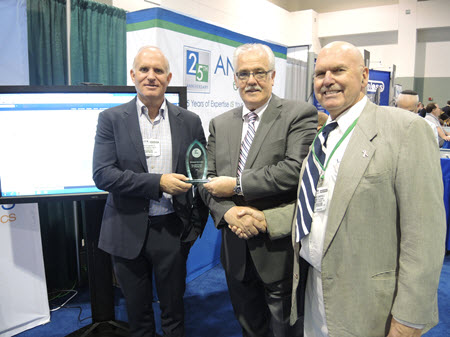Recap: NEFI Expo 2015
A Successful Change in Venue Produces a Fine Show
By Keith Reid
This year’s NEFI Expo moved to the DCU Center in Worcester, Mass. With any such change, the results have to be experienced to gauge success and subjectively the halls saw solid traffic and the educational sessions matched or exceeded similar events in the industry in attendance and quality. The cost to attendees and exhibitors and general accessibility were certainly favorable compared to past locations, such as Boston.
Overall, there were over 2,200 registrants for the event. The trade show featured over 175 vendors, of which 40 were first-time exhibitors. A wide range of educational opportunities saw roughly 240 attended the general educational sessions and 250 the technician-focused sessions. Where networking is concerned, the Wednesday night (June 10) reception at the Worcester Art Museum was attended by almost 300 people.
“It was a tremendous success,” said NEFI Chief Operating Officer Martha Leshine. “This was my first time putting on a trade show so I am pleased with the comments I have heard post show. The layout and location of the DCU Center worked well for the flow of the events on site and then for the city at night. I believe people thoroughly enjoyed the Art Museum and networking in a different environment. It was nice to see business still being conducted while others were breaking down their booths on Thursday.”
On the education front, while sessions were offered in a range of operational areas FON staff focused on the more fuels-related topics.
For example, the session Declining Distillate Values and the Impact on Bioheat Fuel highlighted that biodiesel has proven to be directly cost competitive with petroleum diesel much of the time, with no small degree of assistance from RINs. The session was presented by Gene Gebolys of World Energy. However, Gebolys did note that when the margin situation is not in favor of producers and suppliers relative to petroleum diesel in the market, production will be curtailed. Blenders need “to have supply contracts in place” as buying on the spot market will be uncertain.
The session Price Protection & Advanced Risk Management by Gary Sippin of Destwin covered a range of hedging approaches and that can be used to address risk. One highlight was “incremental hedging” which involves selling price protection continually throughout the year while synchronizing hedging, with software keeping track. The main advantage of this was spreading out the internal workload involved with getting perhaps thousands of customers under contract over a year instead of a short period of days.

In Biodiesel Fuels: How to Sell Beyond The Abritridge Paul Nazzaro of the Nazzaro Group made a strong argument that Bioheat was necessary for companies “that wanted to be in business 50 years from now.” Companies that were not on board will increasingly find themselves at a competitive disadvantage. Nazzaro also expanded on the points made by Gebolys that while the tax incentives can be uncertain year-to-year, they really result in almost a lottery ticket style reward when they come through. And because these tax credits are part of a batch of tax credits impacting different industries, the politics against seeing them disappear completely are currently limited as it’s unlikely to see an individual tax credit be dropped.

Sean Cota, of Cetane Associates, presented the session Propane in New England: Knowing the Regulations and Supply Chain. He discussed some of the advantages with propane for the oil marketer looking to diversify. These centered on providing a multi-fuel offer to the customer, good margins, similar delivery systems, similar legislations and a long-term increase in value of the business. On the disadvantage side, he noted that it is cost intensive which helps offset some of the added margin. A lot of that cost comes from customer tanks, but there is an advantage in that “those tanks are yours and you want to own those tanks,” he said. “It creates sticky customers.”

The trade show floor featured a variety of companies offering a range of solutions for the industry. Space prevents too detailed of an accounting, but here is a rundown of some of the solutions on display. We apologize for any companies that we might have missed.
- Heat Solutions highlighted its marketing system to hook up dealers with high quality, automatic delivery accounts. The company is now doing business in 12 states, has over 140 dealers in the program and almost 80,000 customers.
- Tank Utility (see our New Vendor Awards).
- UEI Test Instruments showcased its DL 419 and DL 429 clamp meters. Both feature a range of traditional capabilities with the DL 429 offering an application based capability wirelessly to smart phones and tablets.
- Charity Oil (see our New Vendor Awards).
- BOSCH displayed its Greenstar FS Series specifically designed for the replacement boiler market. Able to use either natural gas or propane, it offers a 95% AFUE capability. He
- VA Amplifier was offered as a wireless solution that eliminates the need to run from VA to the nozzle, thereby eliminating the need to Croucher stretch uncomfortably or for PVC pipes or long tubes to listen to VA.
- Fleet Navigator (see our New Vendor Awards).
- Caleffi Hydronic Solutions at a range of new equipment on display but highlighted the multi-functional separator SEP4. It creates a low-pressure loss zone, making connected primary and secondary circuits hydraulically independent, and the flow in one circuit does not interfere with the flow on the other. Also, a widened cross-section decreases the flow velocity and the internal element facilitates the release of microbubbles.
- The Ecogreen Tank Monitor was on display and works with propane, fuel and liquid tanks up to 75 feet tall. The company cites reliability and versatility as key capabilities. For example it is solar powered so there’s no worry about battery life, and simple, easy-to-use screens allow access to tank data level history and forecast days to empty from a computer, smartphone or tablet.

